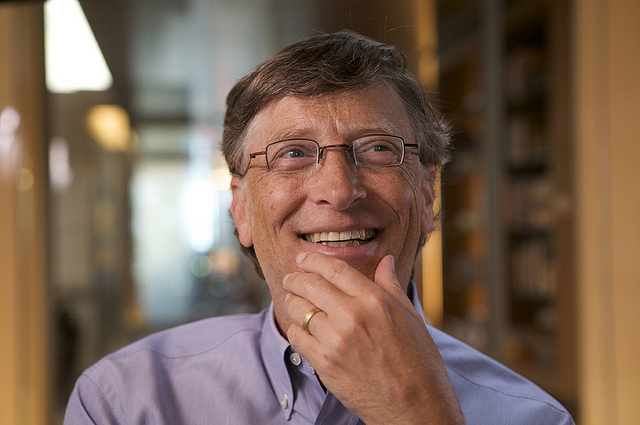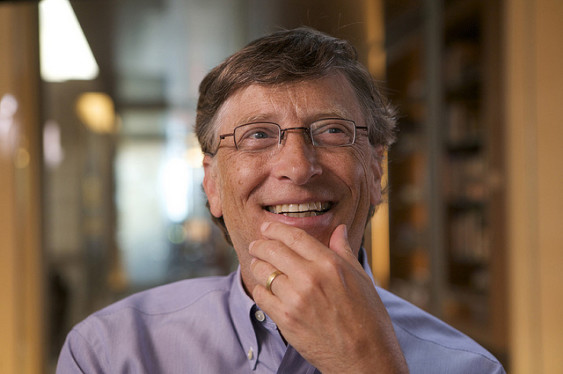Bill Gates told Rolling Stone that “climate change is a terrible problem, and it absolutely needs to be solved. It deserves to be a huge priority.” Yet the foundation that bears his name—the Bill & Melinda Gates Foundation—has invested $1.4 billion of its endowment in fossil fuels.
A Seattle campaign has just launched to change that. The Gates Divest campaign is asking the world’s largest charitable foundation to make another contribution beyond its valuable grants and charitable activities: to act in accordance with its values and fully divest from fossil fuels. The move comes on the heels of a March 2015 call by The Guardian newspaper, in partnership with 350.org, to “Keep it in the Ground,” a campaign that also called on the Foundation to divest. Already that campaign has garnered over a quarter of a million signatures and brought significant attention to the divestment movement. Now, with a local campaign ramping up in its home town, will the Gates Foundation go along?
To understand what is at stake—and why the divestment movement matters to the Northwest and globally—let’s take a moment to examine the details.
What is divestment?
Simply put, divestment is the act of removing an investment. It is also an advocacy tactic used to boycott industries or practices that are morally intolerable. Divestment was first popularized in the 1970s and ‘80s, when college students across the US sought to protest apartheid in South Africa and pushed their universities to shift institutional investments out of companies that traded with or had operations in South Africa. Divestment made it harder to do business in South Africa, and it played a major role drawing attention to the problem and ending the era of apartheid.
The Fossil Fuel Divestment movement
Now, a new divestment movement has taken center stage: moving investments away from fossil fuels, principally coal, oil, and natural gas. Started by 350.org and Bill McKibben in 2012, the fossil fuel divestment campaign is the fastest-growing divestment campaign ever, with hundreds of chapters around the world. The movement includes 392 institutions that are divesting—churches, universities, pension funds, government organizations, and foundations.
One of the campaign’s biggest achievements so far has been in California. On September 2, 2015, California’s Assembly voted to divest the state’s public pension funds from coal. This is significant not only because California has the largest pension funds in the nation, but also because the move would represent the first ever law devoted to fossil fuel divestment. If Governor Jerry Brown signs the bill, it would mean more than $483 billion in stocks that are free from coal.

Take on the really tough problems by Jack at Wikipedia used under CC BY-SA 2.0
California’s Senate President Pro Tem Kevin de Leon remarked, “Coal is losing value quickly, and investing in coal is a losing proposition for our retirees; it’s a nuisance to public health; and it’s inconsistent with our values as a state on the forefront of efforts to address global climate change.”
The Fossil Free campaign scored another win in September 2014 when the Rockefeller Brothers Fund, a large New York-based charitable foundation, divested from all fossil fuels in order to better align their endowment’s assets with their mission of promoting sustainability. It was a curious turn of history given that much of the Rockefeller family’s fortune came from oil.
Perhaps the biggest Northwest win for the divestment movement has come from the University of Washington (UW), which divested from thermal coal (that is, coal used for producing electricity) in May 2015 and invested $25 million into renewable energy in February 2014. These decisions resulted from a three-year campaign of persistent pressure from student activists (including myself), who are continuing to push UW for full fossil fuel divestment.
The point of divestment
“If it is wrong to wreck the climate, then it is wrong to profit off of that wreckage.” That’s how the Fossil Free campaign frames its objective. When moral and intellectual leaders divest publicly, they revoke the legitimacy and social license of coal, oil, and gas companies to recklessly pursue business models that threaten civilization with catastrophic climate change. In most cases, divestment aims not to bankrupt an industry directly, but to stigmatize it and undermine market confidence in it.
The theory goes that by changing market norms, other partners such as banks, future employees, and contractors will feel less willing to work with coal, oil, and gas money. It seems to have worked with the planned development of a controversial coal mine in Australia; many large banks refused to finance the project. Concerted efforts to tarnish the public image of an industry or company can also result in falling stock prices. Or divestment movements can lobby for restrictive legislation to further constrain the stigmatized firms, and both the South Africa and tobacco divestment campaigns have had some success on this front. For the Fossil Free divestment campaign, restrictive legislation might be a price on carbon pollution, a restriction on further exploration for fossil fuels, or some other type of climate protection policy.
Stranded assets and the carbon bubble
In the now landmark issue of its 2012 World Energy Outlook, the International Energy Agency stated that “No more than one-third of proven reserves of fossil fuels can be consumed prior to 2050 if the world is to achieve the 2 degrees Celsius goal.” More recent research published in Nature is more specific. According to the study’s authors, if the world is to have even a 50 percent chance of limiting global temperatures to a 2 degree rise, “a third of our oil reserves, half of gas reserves, and over 80 percent of current coal reserves should remain unused.”
“If it is wrong to wreck the climate, then it is wrong to profit off of that wreckage.”
The tricky part of this is that although they have been yet to be burned, the carbon-based fuels are already bought and accounted for in the share price of every fossil fuel company. If (or when) we enact a climate policy to cap fossil fuel usage to a level that would keep global temperatures below two degrees of warming, then those assets already accounted for in the market will become stranded assets. The value of these stranded assets, a sort of carbon bubble, has been estimated at around $20 trillion (larger even than the housing bubble). For financial reasons alone, then, institutions would be wise to divest from the fossil fuel industry. It would be the surest way to safeguard themselves from the risk of costly stranded assets. In fact, to do otherwise is to bet on a failure of climate policy and severe damage to the global climate.
Why target the Gates Foundation?
The Gates Foundation is the richest charitable foundation in the world—by a long shot— but that’s only part of the reason why the Fossil Free campaign is asking Gates to divest. As it turns out, Gates Foundation money is so big that it represents a noticeable share of the vast fossil fuel industry. The Intergovernmental Panel on Climate Change estimates that the global economy must see a $30 billion reduction annually in the fossil fuel sector in order to have a chance of remaining below the 2 degree Celsius target. Thus, if the Gates Foundation divested its full $1.4 billion in fossil fuel holdings, it would represent roughly 2 percent of that $30 billion this year, according to the research done by Alec Connon and Alex Lenferna.
Yet the bigger impact of Gates Foundation divestment would be the ripple effect of thought leaders like Bill and Melinda Gates showing their disapproval of coal, oil, and gas companies. A threat multiplier, climate change hits hardest the poorest and most vulnerable people on earth, primarily in the global south, where the Gates Foundation does most of its important work combatting poverty. If the coal and oil companies that the Foundation now invests in are allowed to continue their business unchecked (as they plan to on behalf of their shareholders), the Foundation’s work to end poverty will become more difficult—and maybe impossible.

Quote at Gates Foundation HQ by Jules Antonio used under CC BY-SA 2.0












hb
The Gates Foundation just accepted $2.84 billion from Warren Buffett.
Buffett makes a lot of money hauling coal and oil on the BNSF railroad and he owns a chunk of Phillips 66 oil company.
Should the Gates Foundation, and other charities, refuse this money derived from fossil fuels?
Jay Taber
Buffett and the Rockefellers own 350 as well.
http://publicgood.org/pdf/Bomb-Train-Timeline-Public-Good-Project.pdf
Jay Taber
Fossil fuel divestment is a shell game concocted by Wall Street.
http://acultureofimbeciles.com/2014/09/divest-invest-shell-game/
Jay Taber
350 is a front for Wall Street interests.
http://www.wrongkindofgreen.org/2015/04/30/just-say-no-to-350/
Jay Taber
Mass hypnosis has hoodwinked progressives.
http://www.wrongkindofgreen.org/2014/09/15/charms-of-naomi-the-mystique-of-mass-hypnosis/
John Bremer
Why doesn’t divestment apply to coal plants, coal trains, and bomb trains? At the end of 2014, the Gates Foundation held $12 billion of stock in Berkshire Hathaway, the largest US company that refuses to disclose its greenhouse gas emissions, the largest emitter of greenhouse gasses in the State of Iowa, as well as the owner and operator of the BNSF railroad, which has plagued our state with coal trains and bomb trains. Gates could use his position on the board of Berkshire Hathaway to influence company policy affecting coal trains, bomb trains, and coal fired power plants. Gates owns 13 percent of a Canadian coal train company.
Sandy Robson
Bill Gates started building his position in Canadian National Railway in 2006. CN transports coal, crude oil, petcoke, and other fossil fuel commodities.
“In 2010 Buffett bought the rest of Burlington Northern Santa Fe Rail for $44 billion while Gates *increased his stake in CN and, by April of 2012, became CN’s single largest shareholder. (*By 2006 approx. $1.4 billion of Gates’ $3.4 billion portfolio was invested exclusively in CN Rail.)” – from Oct. 2013 Counterpunch(dot)com article.
From the linked-to 2012 article below:
http://www.financialpost.com/m/wp/blog.html?b=business.financialpost.com//news/transportation/bill-gates-ups-cn-rail-stake-to-12
“As a result, Mr. Gates is deemed to have a beneficial ownership of and/or control or direction of roughly 11.98% of CN, or 51.7 million of its outstanding shares, for a combined value of roughly $4.7-billion based on Tuesday’s close of $90.36 a share on the Toronto Stock exchange.
“This not only makes Mr. Gates CN’s largest shareholder, but brings him closer to the 15% ownership cap placed on the railroad for any one investor stemming from its privatization in 1995.
Gates is clearly in the thick of all things fossil fuel.